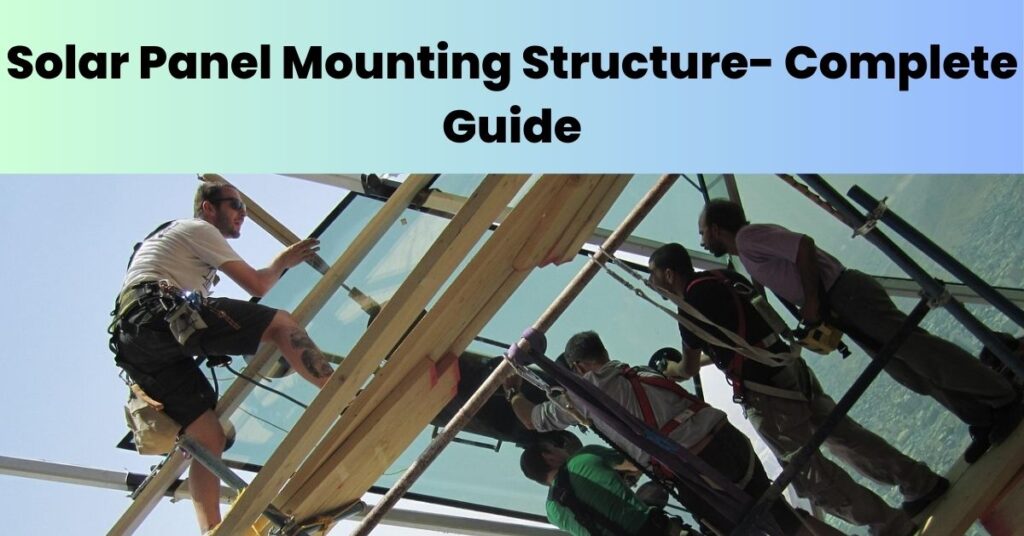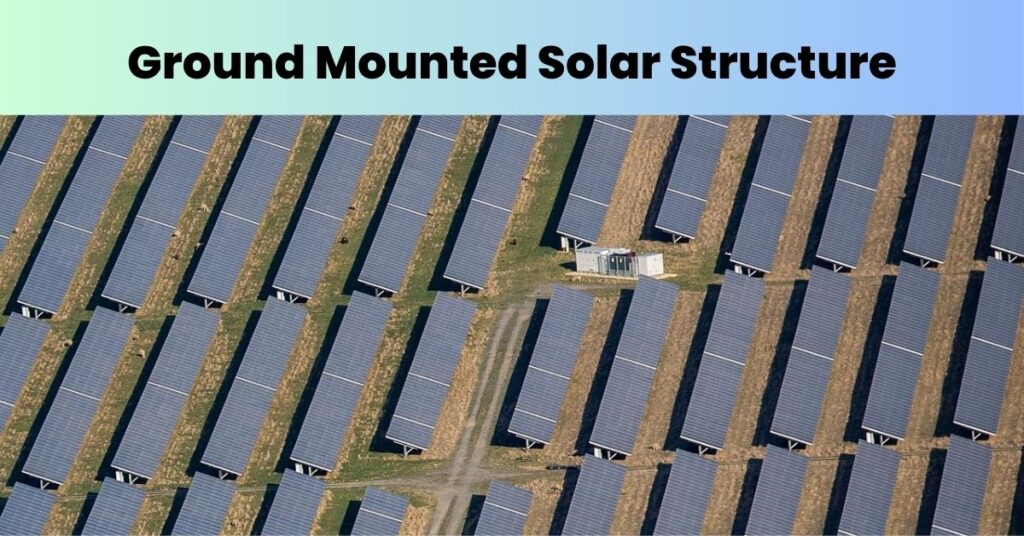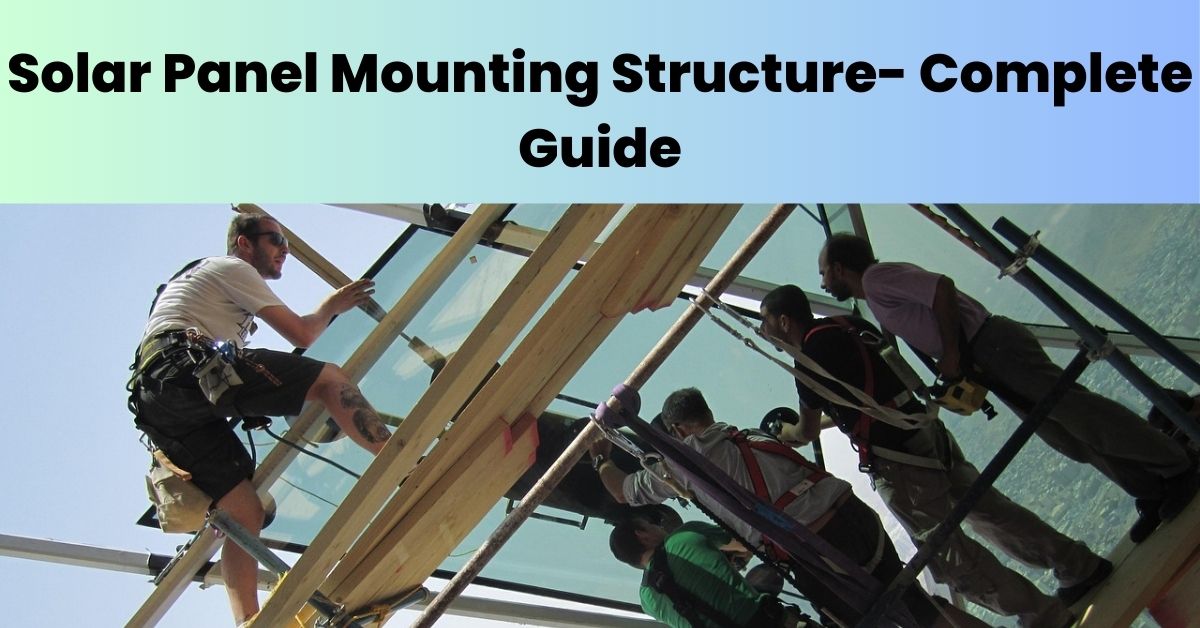
If you have ever wondered how solar panels are held up on a rooftop, the answer is a device known as a solar panel mounting structure.
The solar panel structure underneath keeps everything stable, secure, and functioning properly even though the panels themselves absorb sunlight and convert it into electricity.
Understanding the function of the Solar panel mounting structure is crucial whether you’re considering purchasing solar panels for your house, place of business, or even your farm.
It’s more than just a frame, it has a direct impact on the energy output and lifespan of your panels.
Everything you need to know about Solar Panel Mounting Structure will be covered in this guide, from the fundamentals to more complex options, in an understandable and straightforward manner.
A Solar Panel Mounting Structure: What Is It?
The framework or the support system which is used to back solar panels is called a solar panel mounting structure. You can consider it as a “skeleton” that keeps everything together.
It keeps the panels at the right angle and direction so they can get the most sunlight during the day.
Additionally, it shields your solar system from natural disasters like severe winds, torrential rain, and even small earthquakes.
Therefore, a robust, well-designed structure is crucial for both safety and performance.
Why Does It Matter So Much?
Although it may not be the most visually appealing component of the solar system, the structure has a significant impact on the following:
• The amount of energy your system generates.
• The lifespan of your panels.
• The ease of system maintenance- How effectively the system manages inclement weather.
Whether you’re installing the system on a roof, the ground, or an open field will also affect the structure you choose.
Also Read: https://thesolarpanelinfo.com/solar-panel-yojana-2025/
Types of Solar Panel Mounting Structures:
From simple to more complex configurations, let’s dissect the most prevalent kinds:
1. Structures Mounted on Roofs
These are the most common kind, particularly for small buildings and homes. Metal frames and solar panel mounting clamps are used to secure the panels when they are mounted directly on your roof.
Advantages:
• Conserves space, which is particularly helpful in urban areas.
Utilizes rooftop space, which is typically underutilized, it is less expensive than alternative solutions.
Roof Mount Types:
• Fixed Tilt: The panels are positioned at a single, predetermined angle. Because of its simplicity and immobility, this setup is less expensive, but it might not always receive the most sunlight throughout the year.
• Adjustable Tilt: This feature helps boost energy output by allowing you to alter the angle based on the season.
The mount or the stand of these configurations is generally made of lightweight and rust-resistant aluminium.
2. Ground Mounted Solar Structure

Ground-mounted solar systems may be a better option if you live on a farm or in an open area like your yard. These are basically ground-level solar structures with panels scaled or attached on top.
Benefits include:
• Easier to maintain and clean.
• Cooler panels, which enhance performance.
• Greater adaptability in terms of angle and direction
Ground Mount Types:
• Sturdy and immobile are fixed ground mounts. Excellent for big systems where simplicity and cost are important considerations.
• Pole Mounts: Panels are fixed to a pole, which occasionally tilts or rotates. These work well on uneven terrain or in areas with plenty of space.
The material used for solar panel structure needs to be more durable; stainless steel or galvanized steel are frequently used because they can withstand higher weights and inclement weather.
3. Systems for Tracking the Sun
This kind of solar mounting structure is referred to as “smart.” During the day, these systems move the panels to follow the path of the sun. In other words, more sunshine equals more electricity.
Tracker Types:
• Single-Axis Trackers: These move eastward in relation to the sun.
• Dual-Axis Trackers: These also change position in accordance with the seasonal path of the sun.
Benefits include:
• Up to 30% more electricity
Cons:
• More costly to maintain and install
• Typically utilized in large-scale projects or solar farms
Materials for Solar Panel Structure
The solar panel structure material and design are must and are very important. It must be lightweight, durable, and impervious to rust—especially on rooftops.
The following materials are frequently used:
• Aluminium: rust-proof, lightweight, and simple to install. Ideal for roofs.
Galvanized steel is robust and durable. Ideal for large farms and ground setups.
• Stainless steel: more costly but incredibly durable.
The location of the panel installation and the type of weather the system must endure will determine the best option.
Clamps for mounting solar panels: The Little but Important Aspect
The tiny parts that genuinely secure the panels to the structure are called solar panel mounting clamps.
Two categories exist: Hold panels side by side with mid clamps and secure the outer edges with end clamps.
Because they keep the panels safe during severe winds and storms, high-quality clamps are crucial.
Typically, they are constructed from the same rust-resistant materials as the remainder of the building.
What Determines a Solar Panel Mounting Structure Price?
Below are the primary factors that particularly affect a solar panel mounting structure price:
1. Mounting Type: Fixed mounts are less expensive than tracking or adjustable mounts.
2. Material: Although aluminium is less expensive than stainless steel, it might not be as sturdy in larger configurations.
3. Installation Site: Rough terrain or sloping roofs may call for additional components and labor.
4. Labor Costs: Installing more intricate designs requires more time and skill.
5. System Size: Larger systems require more materials, which raises the price.
Selecting a sturdy, long-lasting structure can save you money over time, even if it costs a little more up front. Also Read: https://thesolarpanelinfo.com/2-kw-solar-panel-price-in-india/
The Importance of Selecting the Correct Structure
The performance of your solar panel system ultimately depends upon the design of the solar panel structure you select.
This is why it’s important:
• More Sunlight = More Power: Your panels will absorb more sunlight if they are oriented and angled correctly.
• Stability & Safety: Even during storms, everything is kept safe by a well-constructed structure.
• Less Maintenance: Longer life and fewer repairs are associated with strong materials.
• Peace of Mind: Panels moving, shattering, or falling are not concerns.
Conclusion
Therefore, the solar panel structure design ensures that the solar panels can continue to convert sunlight into electricity for at least 20 to 25 years.
Investing in a robust, intelligent structure is worthwhile, regardless of whether you choose a straightforward rooftop setup or a sophisticated tracking system.
It guarantees a smooth and dependable solar journey, protects your investment, and improves performance.
Don’t overlook the mounting structure details if you intend to switch to solar power.
Make sure you understand how everything fits together by speaking with your installer and asking questions regarding the material used to construct the solar panel.
Because when it comes to solar – it’s not just about what’s on top, but what’s holding it up.
FAQ’S:
1. What are the structures of solar panel installation?
Solar panel installation structures provide a stable framework to mount solar panels, optimizing sunlight capture and withstanding environmental factors. Common types basically include rooftop, ground, and pole-mounted structures. Rooftop solar structures are popular for residential and commercial buildings, while ground mounts are suitable for larger installations. Pole-mounted systems are generally used when ground space is less.
2. How many mounting brackets per solar panel?
Typically, solar panels require at least four mounting brackets, with one bracket placed in the corner of the panel for use and support.
3. What’s the best angle for a solar panel?
The ideal angle for solar panels is primarily determined by latitude with a general rule to match the panel’s tilt to your location’s latitude for year-round performance.
For northern India, a tilt of approximately 20 degrees is suitable, while southern India requires a shallower angle of around 10 degrees.

